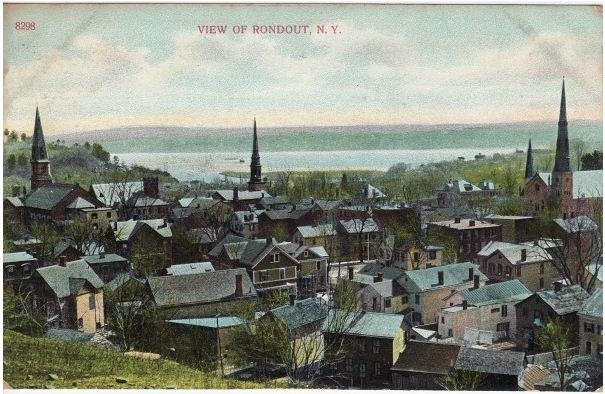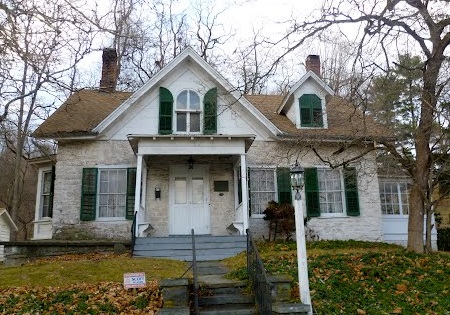During this time of Presidential politics, I thought it would be fun to revisit the Presidential politics of the 18th century…where it all began!
Portraits from left to right: George Clinton by native-Kingston artist John Vanderlyn; Thomas Jefferson by Rembrandt Peale; Aaron Burr also by John Vanderlyn
Old Ulster in the Electoral Colleges
From Olde Ulster: An Historical and Genealogical Magazine, April 1906
In the year 1904, Old Ulster received the high honor of the nomination of one of her sons by one of the great political parties of the United States for the eminent office of President of the United States. The purpose of this paper is to put on historical record all similar honors to Ulster’s sons as the electoral colleges in various states have designated Ulster county men as their choice for either President or Vice-President of the United States. In the early presidential elections it was rare when some electoral college did not thus name a resident or at least a native of this old country.
Before the Revolution, when the names of George Clinton and Charles DeWitt were proposed for election to Congress, Cadwallader Colden, the Governor under Royal authority, objected because “they are fiery young radicals.” These men were at one with Samuel and John Adams in Massachusetts, and with Thomas Jefferson and Patrick Henry in Virginia in the battle for liberty not only, but were with Samuel Adams, Virginia And North Carolina in the succeeding fight that the Constitution contain a bill of rights, free speech, free press and the free exercise of religious liberty. This was the ground of the opposition in these states to the adoption of this instrument and their fight secured these things in the fundamental law by the early amendments. As George Clinton was one of the champions of this fight he became a peculiar favorite in Virginia and North Carolina. We will see how this was remembered in after years.
The Constitution of the United States at the first allowed each elector in the electoral colleges in the different states to name two men for the office of President. When the votes were counted in Congress the one receiving the greatest number of votes should be President and the one receiving the next highest Vice-President. This was provided that such greatest number be a majority of the votes cast. From the adoption of the Constitution in 1787 until the death of George Clinton in April, 1812, there were five presidential elections. At every one of these five elections Clinton received the votes of electors for President except in 1800 and in 1804, and in 1804 he received the majority of the votes for Vice-President and was elected; while in 1808, when he was re-elected Vice-President he also received six votes for President. At the election in 1804 the Constitution had been amended and votes were cast for President and Vice-President as they are now.
The first election under the Constitution for President was in 1788. In every State the first choice was George Washington. To this there was no discordant voice. But the second choice of the electors disclosed the existence of differences which foreshadowed the two theories which resulted in the two schools of thought into which the country divided: the Hamilton and the Jefferson – the privileged and the popular. Clinton was an Ulster County man and from the first ranged with Jefferson.
At the election in 1788 Virginia cast three electoral votes for George Clinton for President. So far parties had not been far developed. When the second election was held in 1792 the people began to group around leaders. Washington was again elected without a dissenting vote. The second choice of the electors is worth noting. John Adams and George Clinton as representing the Federalist and the Democratic-Republican schools received all the electoral votes for President but five; four of which were given in Kentucky to Jefferson and one in South Carolina to Aaron Burr. Of the electoral votes Adams received seventy-seven and Clinton fifty. The votes for Clinton were twelve from New York; one from Pennsylvania; twenty-one from Virginia; twelve from North Carolina and four from Georgia. Accordingly John Adams became Vice-President.
By 1796 party lines were still more definitely drawn. Washington was now out of the field by his own decision. The Federalists were more thoroughly organized than their opponents. They massed their votes on John Adams and elected him President while their antagonists divided their strength between Thomas Jefferson, Aaron Burr, Samuel Adams, Oliver Ellsworth and George Clinton. Had there been an agreement among the electors Jefferson would have been elected as the party controlled enough votes. As it was, Adams had but three more electoral votes than Jefferson and became President and Jefferson Vice-President. At this election George Clinton once more received three electoral votes from Virginia, to which were added four from Georgia.
The election in 1800 found both parties wiser in political management. It resulted in the casting of a majority of the electoral votes for Jefferson and Burr – each receiving seventy-three. John Adams had sixty-five and Charles Cotesworth Pinckney sixty-four. The House of Representatives chose Jefferson President. No votes were cast for Clinton.
The attempt on the part of Burr to secure the election when it was evident that Jefferson was the choice of the electors led to the amendment of the Constitution and electors voted directly for each office as is done today. At the election in 1804 Jefferson was re-elected President and George Clinton was elected Vice-President, each receiving one hundred and sixty-two votes. The states voting for them were New Hampshire, seven; Massachusetts, nineteen; Rhode Island, four; Vermont, six; New York, nineteen; New Jersey, eight; Pennsylvania, twenty; Maryland, nine; Virginia, twenty-four; North Carolina, fourteen; South Carolina, ten; Georgia, six; Tennessee, five; Kentucky, eight; Ohio, three.
The presidential election of 1808 took a strange form. Jefferson refused to stand for a third term and his followers named James Madison with George Clinton for re-election as Vice-President. Many Democrats were displeased because Clinton had not been made the successor of Jefferson. In the State of New York six of the electors voted for Clinton for President and three of these for Madison for Vice-President, while the other three voted for James Monroe for the same office. The other New York electors followed the lead of their party through the country and elected Madison President and Clinton Vice-President.
Before the next election (1812) the Vice-President, George Clinton, died while presiding over the Senate in Washington. The Federalist Party was hardly in condition to contest the re-election of Madison. They made no nomination for the Presidency but resolved to take advantage of the feeling in New York that George Clinton should have been chosen in 1808. He was now dead. But his nephew, DeWitt Clinton, was rapidly becoming a first-class statesman. Although he was a Democrat they determined to support him and gather in, if possible, the Clinton influence. They were successful in New York and DeWitt Clinton received its electoral votes. With the twenty-nine from this State he received the votes of New Hampshire, Massachusetts, Rhode Island, Connecticut, New Jersey, Delaware and Maryland – eighty-nine in all. DeWitt Clinton was a native of Old Ulster, whether he was born while his mother was on a visit to the house of her father in Napanoch, as is claimed, or whether born in that part of Ulster now in Orange county.
From 1812 no electoral vote was cast for an Ulster County candidate until the election of 1904 when Alton B. Parker received one hundred and forty votes in the electoral colleges in various states. Olde Ulster has shown in the issue for April 1905, (Vol. I, page 102) to what extent Old Ulster can claim Theodore Roosevelt, the successful candidate in that election, as one of her sons.




